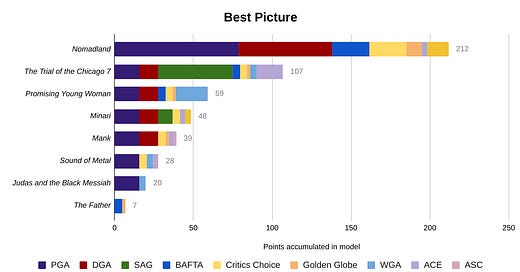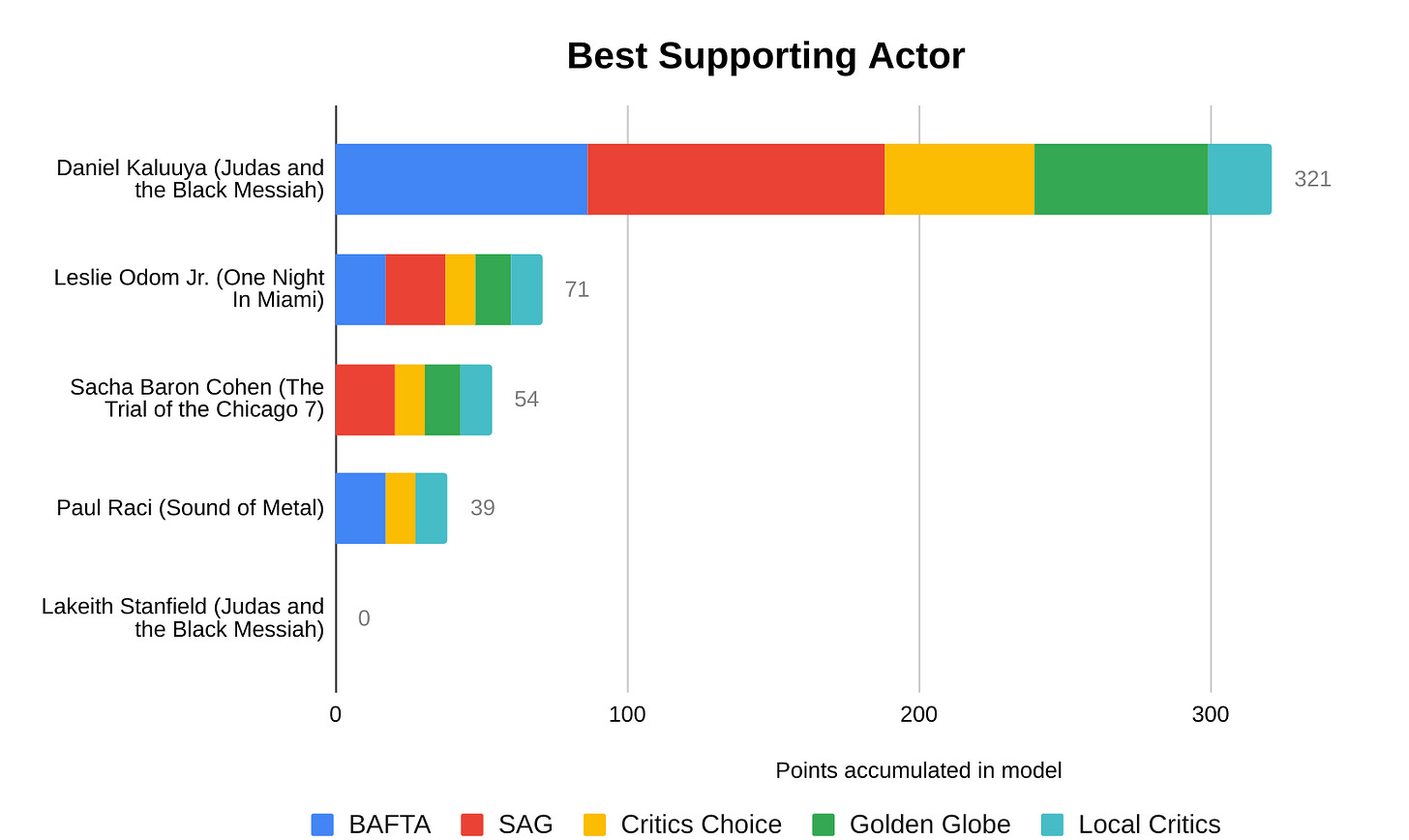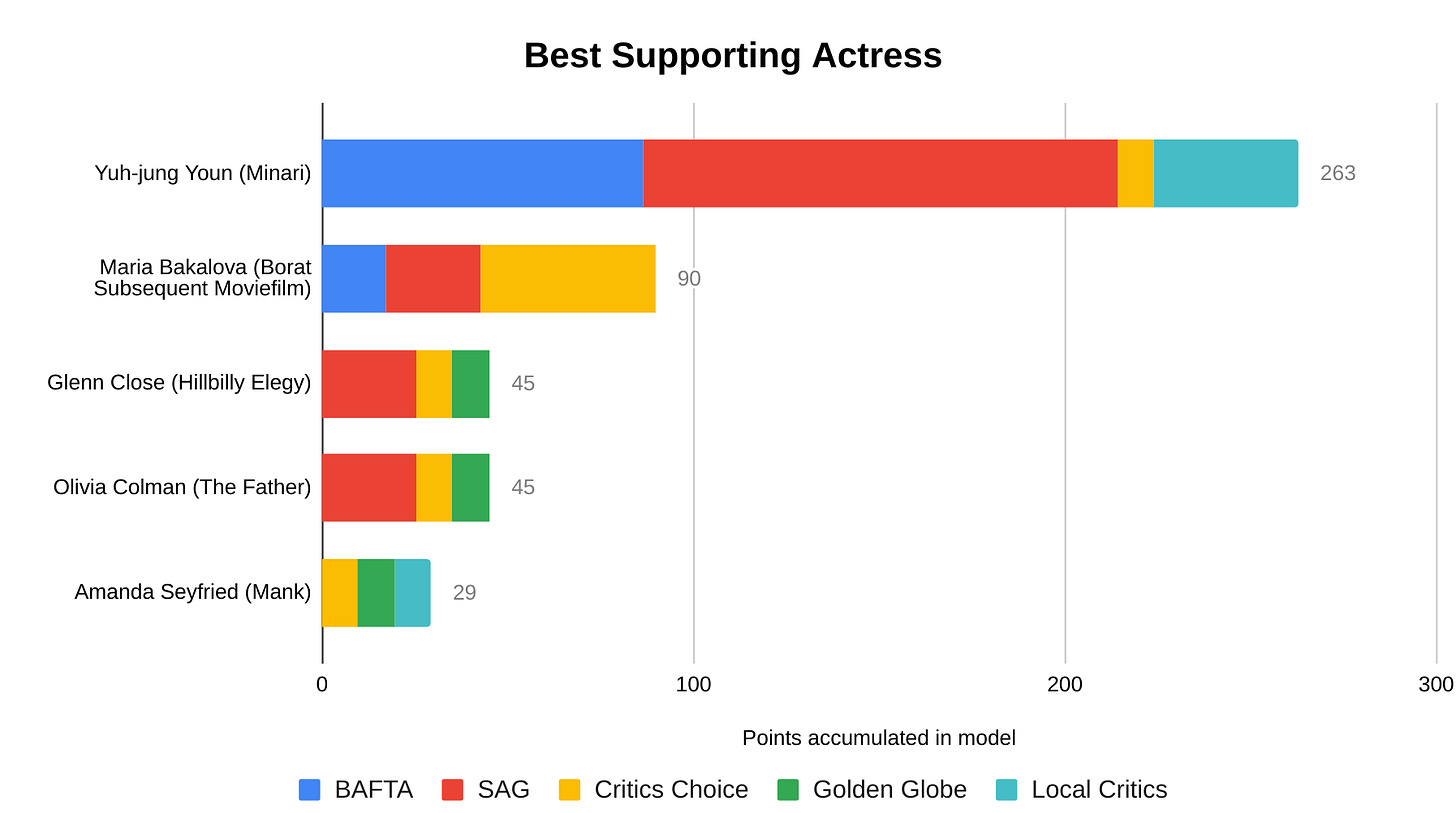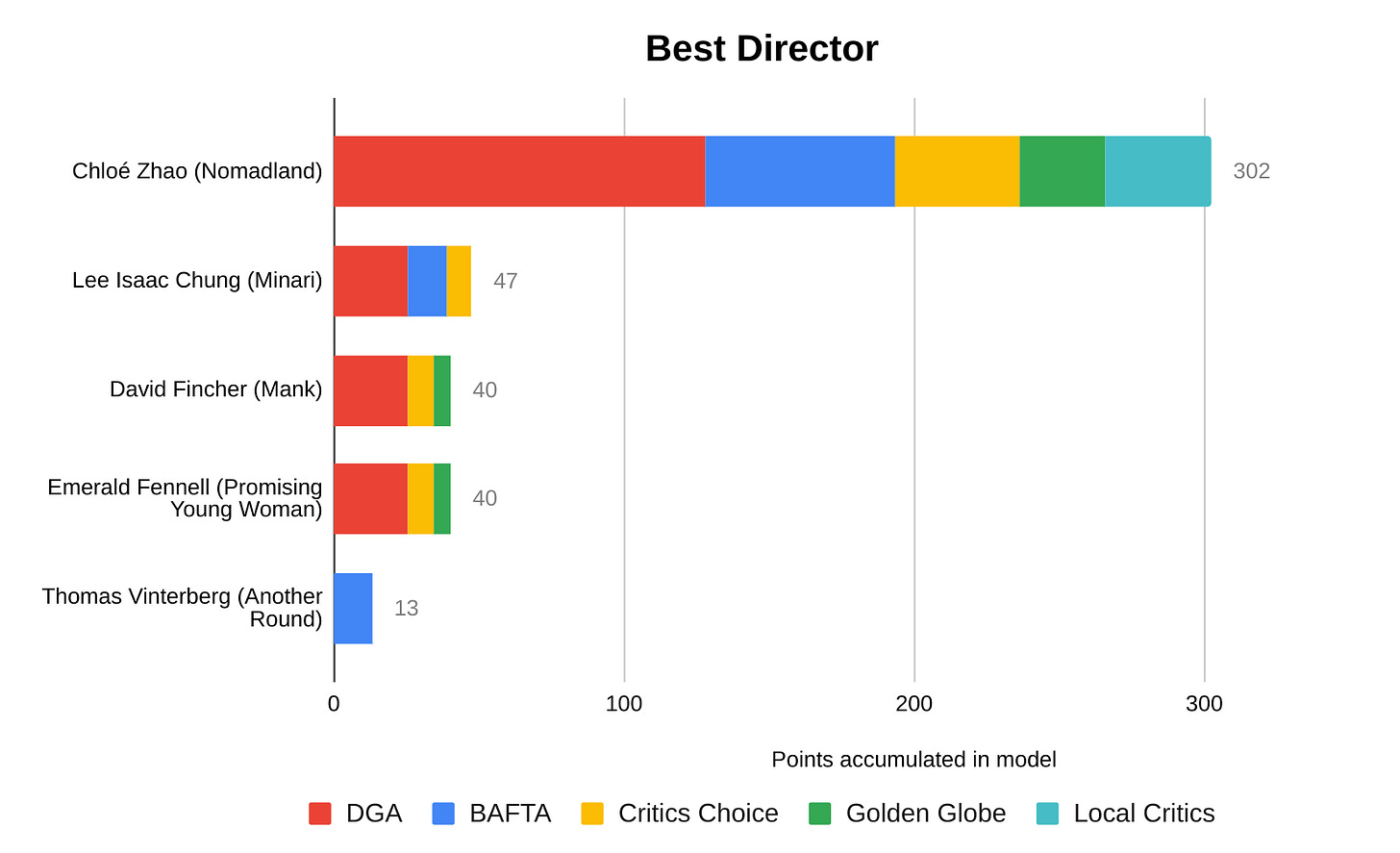Numlock Awards: The Oscars 2021 Final Forecast
Numlock Awards is your one-stop awards season newsletter, and it’s back! Every week, join Walt Hickey and Michael Domanico as they break down the math behind the Oscars and the best narratives going into film’s biggest night. We’re doing another post-Oscar mailbag, send questions to awards@numlock.news! Today’s edition comes from Walter.
Enjoy the show tonight everybody!
Best Supporting Actor
Start with an easy one here, Daniel Kaluuya (Judas and the Black Messiah) has scooped up each of the major precursor prizes at SAG, BAFTA, Critics’ Choice and the Golden Globes. With only four precursor prizes, the supporting actor categories tend to either coalesce quickly around a single winner, or not at all; in this weird little deferred and abridged and remote season, that happened in short order on this one.
Best Supporting Actress
Yuh-jung Youn (Minari) never once left first place according to the model through the entirety of this season, having racked up a surfeit of recognition from local critics.
Still, for a while this category was unsettled, with Jodie Foster (The Mauritanian) winning a Golden Globe but not a subsequent Oscar nomination, and Maria Bakalova (Borat Subsequent Moviefilm: Delivery of Prodigious Bribe to American Regime for Make Benefit Once Glorious Nation of Kazakhstan) winning at the Critics’ Choice. It wasn’t until back-to-back wins at SAG and BAFTA that Youn came into a striking lead, and right now it’d be a surprise if she loses.
Best Director
In baseball, it’s considered a faux pas to talk about a pitcher who appears to be in the process of throwing a no-hitter. I’m not sure why I felt compelled to bring that information up at this time, blowing my once-per-season sports metaphor on the very last day of the season!
Anyway, here’s a chart.
Best Actor
This looks way closer than I believe it truly is.
Hopkins (The Father) won at BAFTA, which as I mentioned last week I think is more a function of home-field advantage than an indication he’s breaking what seemed to be unstoppable momentum behind the posthumous campaign for Chadwick Boseman (Ma Rainey’s Black Bottom).
Is this just an esteemed U.K. actor getting recognition from his peers in a season belonging to someone else, or genuine Anthony Ho-mentum? Is Ho-mentum a cursed word that I should have never come up with? Tonight, we find out.
Best Actress
This is the category to watch this year. It’s pretty much a toss-up. Davis (Ma Rainey’s Black Bottom) and McDormand (Nomadland) are the likeliest winners, but in a category like this, that means very little. This is a category selected by a plurality of the votes, first-past-the-post, and the initial picture is so muddy that it really could be anyone’s to win.
The long and short of it is that both BAFTA and SAG are fabulous predictors of this category, and this year they’re going head to head. You may recall that the model is explicitly designed to reward recent precursor performance over older performances, so bigger picture I’m really excited about which of SAG or BAFTA (if either!) ends up being right.
A topic I didn’t really get to explore this year is BAFTA and how they’ve been getting very good lately in the acting categories. The reason is I don’t really have evidence for one of the many theories I have as to why: Is it that BAFTA is getting less British-focused? Is it that the Academy, with a global expansion, is looking more BAFTA-like? Is it just a string of good luck? If McDormand (or Hopkins, for that matter) pulls it off, I’ll be all over this next year.
The model says McDormand. Michael yesterday said Davis. I personally think he’s right on this one and the BAFTAs will take a hit in the rating system. Still, this category will end up being a close one, and all sorts of exciting things can happen when there’s no leader in Best Actress so buckle up.
Best Picture
Oh sweet, it’s the hard one.
You should check out my conversation with FairVote’s Rob Richie last week. I continue to think that assessing precursor prizes remains one of the most effective long-term ways to discern the general possibilities of Oscar outcomes. That said, the past couple years have really been wild in terms of how they ended up going, and I’m generally just the type who wants to understand black box systems rather than ride or die on a single model.
In my talk with Richie, we got at just why the Best Picture category has been so lousy with volatility. My thoughts about what’s been going on with the category come down to two principles:
All nominees have a floor of support (that is, the number of die-hards who rank it first, ride-or-die for Minari, the #7hive, The No-letariat, the Mankees, if you have a Twitter account you know the vibe I’m talking about)
All nominees also have a ceiling of support. These are, overall, the broad number of people who would be, in general, cool with the film as Best Picture.
Under a first-past-the-post system, which is how a lot of precursors are calculated, a high floor can punch your ticket: if you’ve got 35 percent of the vote every time, in a five-candidate race each time that’s probably good enough for a win.
What we measure when we look at precursors is, I think, the floor. That chart is an intuitive measure of how high the floor is for the movies up for an Oscar.
Oftentimes, a solid floor of support is enough to get you an Oscar, but not always.
If a movie is loved by a passionate fan base, but loathed by a lot of people — let’s say a movie like Riddler or Two-Face or Penguin or I know I’m forgetting one but its name momentarily escapes me — it’s got a high floor, but a low ceiling. This kind of movie does bad under ranked-choice voting, it lasts a little longer than most but can’t break the 50 percent threshold to seal the deal.
If a movie is very niche loved but is generally broadly liked, like a Story about a Marriage, it’s got a low floor and a high ceiling. This kind of movie also does bad under ranked-choice voting, it goes down in an early round and its votes get spread to other movies.
In short, one reason we have been seeing a lot of weirdness in Best Picture is that it’s incredibly difficult to suss out the ceiling of support for these movies. In my view, an ideal model would use the floor calculations in that chart above to determine which films likely make it to the final three, and then a reckoning of the ceiling of each to discern a winner. We don’t have a good way to measure that last bit, so I don’t have that model for you.
It is, however, one reason why every year I like to shout-out my friend James England’s model. He applies some principles of head-to-head matchups from his work analyzing college football, and invites people to rate the films against one another. His record isn’t perfect either, but I really like its track record in Best Picture during upset years. This year, his analysis of the votes has Minari winning out. If Nomadland were to miss, I think James (and Michael, for that matter) would end up being right: Minari has a high ceiling of support. Whether Nomadland has a high enough ceiling to capitalize on its demonstrably high floor is something we’ll learn tonight.
One last thing is calculating how much of a “favorite” a movie really is. Every year I do a beta model to try to assign a genuine probability to the scores you see up top. What this essentially comes does to is I use those scores to very, very slightly weight the randomized preferences of 9,400 people in the Academy in a python script simulating the Academy voting using ranked-choice ballots. I run 10,000 simulations, and count up how often the movie came out on top.
This year, using those weights, Nomadland won in 79 percent of the simulations. That’s pretty good, but it’s also what you’d expect of the film that won the DGA, PGA, and BAFTA. That said, there’s still a 21 percent chance Nomadland doesn’t win, and I know a guy who got mean emails for four years predicting something with better odds than that.
That’s also incidentally a little worse odds for Nomadland than genuine bookmakers give it.
I like to rely on PaddyPower, which gives the film 1/6 odds of winning, or about an implied 85 percent chance of winning.
Lastly, not to beat the drum again, but the Academy has changed so much in the past several years.
Hundreds of agents were made full-fledged voting members this year alone. The electorate is in a state of volatility, so it only makes sense that the top prize is, too.
All this means that we’re in for a great night! Best Actress is a toss-up and Best Picture is hardly in the bag. It’s exactly what you want out of this telecast. Good luck all around.










